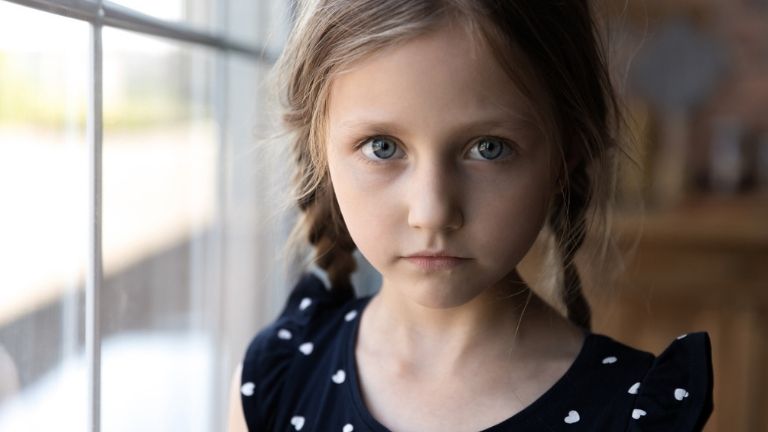Worried about your children’s mental health? For Children’s Mental Health Week, Child psychotherapist Dr Alison McClymont reveals the key signs to look out for
Research published this year by Wysa revealed that one in three 13 to 17 year olds in the United Kingdom showed symptoms of depression or anxiety that warranted an investigation – that’s a staggering 34 per cent of children suffering with their mental health.
Mental health issues are also prevalent in younger kids. One in six children aged five to 16 were identified as suffering a possible mental health disorder in 2020.
Childhood is a rollercoaster and it is completely normal to struggle with developing brains and bodies and to sometimes show behaviours or responses that aren’t desirable.
After all, children are learning every day how to cope with different hormone surges and brain development
One in six children aged five to 16 were identified as suffering a possible mental health disorder in 2020
Usually, obvious examples of mental health triggers are abuse, neglect or maltreatment in the home. Others can be bullying, bereavement or divorce.
But most recently, the pandemic has created huge amounts of anxiety and stress across the population and in some children this has been experienced as fear of germs or dying and has even become full blow OCD for some.
If your child is showing maladaptive responses to an event such as obsessive behaviours or extreme emotional outbursts, it might be worth considering that they need some help.
READ MORE: Experts reveal 5 healthy supplements you probably don’t know about but totally should
What key signs should parents and teachers be looking out for?
Key signs of children’s mental health, are changes in behaviour that are marked and noticeable.
What we mean by this is a change that is either developmentally inappropriate or uncommon for your particular child.
Examples of a change in behaviour could be sudden physical outbursts or verbal aggression, or becoming more tearful than normal, with seemingly little provocation.
It could also be a change that causes significant distress to the child – such as verbalising a lot of fears or anxious thoughts.
Experiencing night terrors or feeling scared to go to sleep can also suggest an underlying anxiety
Look out also for changes in eating or sleeping patterns, also a new onset of toilet trouble, withdrawing from things they once enjoyed, new onset irritability or emotional outbursts, or simply saying ‘I don’t feel good’.
Experiencing night terrors or feeling scared to go to sleep can also suggest an underlying anxiety, as can significant changes in eating patterns – such as refusing to eat or bingeing.
Changes in toilet behaviours could be ‘deliberate’ soiling of underwear, refusing to use the toilet, or sudden onset of bed wetting.
Of course these should take in to account the age of the child, with the understanding it is not uncommon for four to five year olds to regress a little with previously good toilet habits, but it would be uncommon for an eight to nine year old.
The key point is: what was previously normal for your child? Has something changed?
READ MORE: What is Energy Based Therapy and how can it help?
How can parents & teachers help children?
Children sometimes lack the emotional vocabulary to explain what they feel, so it can also be helpful to offer them examples of emotions they might feel, or to help them define the difference between emotions such as anger or sadness.
Parents and teachers can try to maintain an open dialogue with children about both positive and negative emotions and remind them that the experience of BOTH is normal. They should understand that it’s absolutely OK to say I feel angry, sad or embarrassed about something.
Children sometimes lack the emotional vocabulary to explain what they feel
Normalising these emotions can help to open up conversations. It is key that we do not ‘reject’ emotions such as sadness or anger as ‘bad’ – these are normal responses but we have to find ways to express them without being self-destructive.
For example it is helpful to remind children ‘anger is allowed, but aggression is not’, or ‘being sad can help us to feel empathy towards others and can be a useful connecting emotion’.
What sort of questions should we be asking children if we suspect they may be struggling?
Questions we can ask should be curious rather than demanding, for example as opposed to saying ‘tell me what’s going on’, you can state what you’ve observed ‘I’ve noticed you are doing XYZ more or less.’
We can also lead with our own emotions or thoughts as a way to open conversations:
- ‘At the moment I’m feeling XYZ about this, how about you?’
- ‘Sometimes I have felt like XYZ and I did XYZ’
- ‘I’m feeling like XYZ what do you think?’
When to seek professional help?
If your child is experiencing a marked change in behaviour, and especially if this behaviour is dangerous to themselves or others – consult a professional.
Such behaviours that always warrant a professional opinion would be:
- inappropriate sexualised behaviour ie not simply self exploration,
- violence towards other children with the intent to cause serious harm,
- self harm such as cutting or scratching of skin,
- suicidal thoughts.
HEALTHISTA’S ANSWER TO MENOPAUSE; MENOSTART: PRESS PLAY, NOT PAUSE.
The Healthista Menopause Pack is a fully comprehensive online video workshop, led by Dr Dawn Harper; affordable, accessible and covering all aspects of the menopause, for those who need it most.
With expert advice and information from seven credible menopause industry experts, we hope that this online resource will help women navigate common health and wellness changes and challenges they may experience before, after and during the menopause.
Like this article? Sign up to our newsletter to get more articles like this delivered straight to your inbox.























































